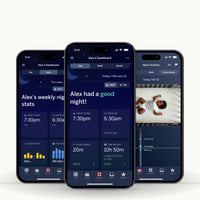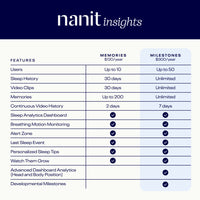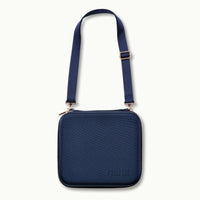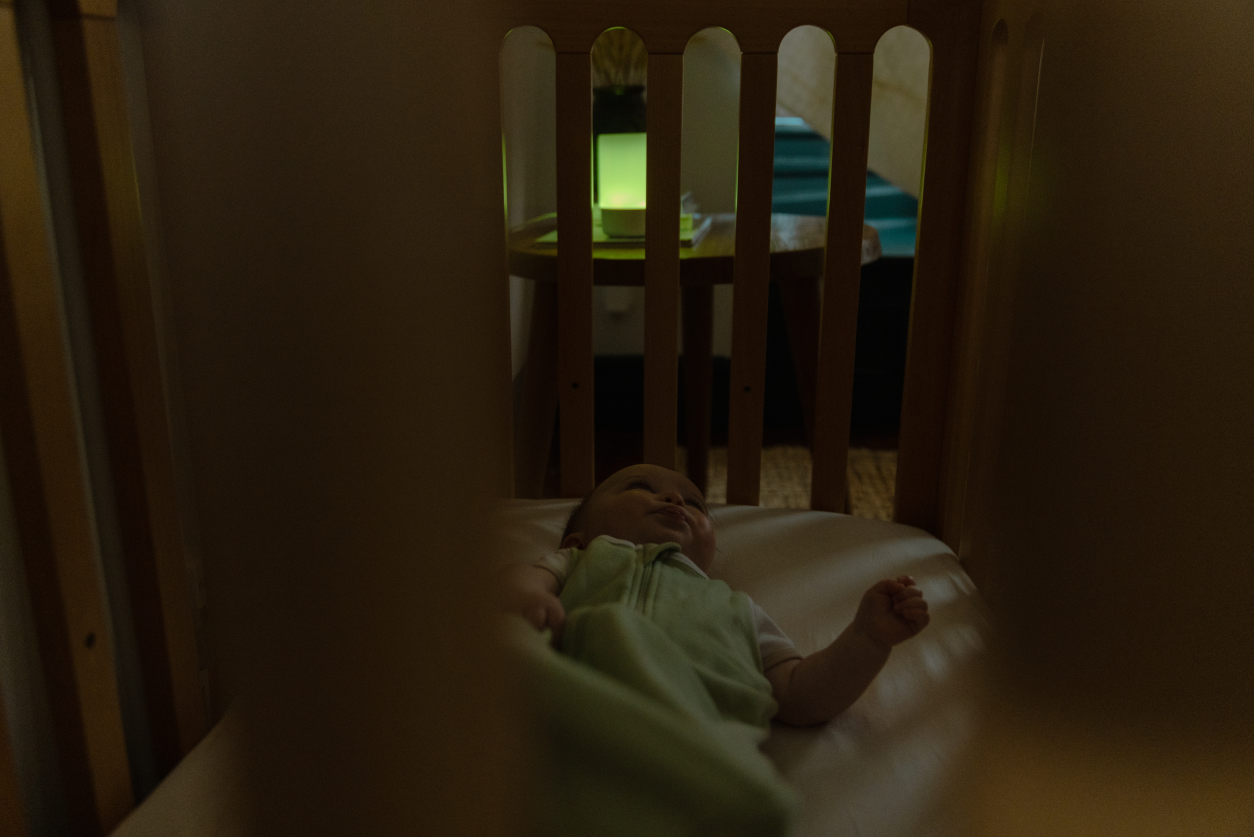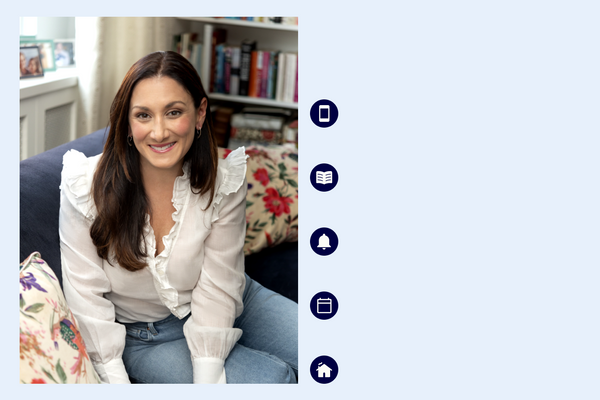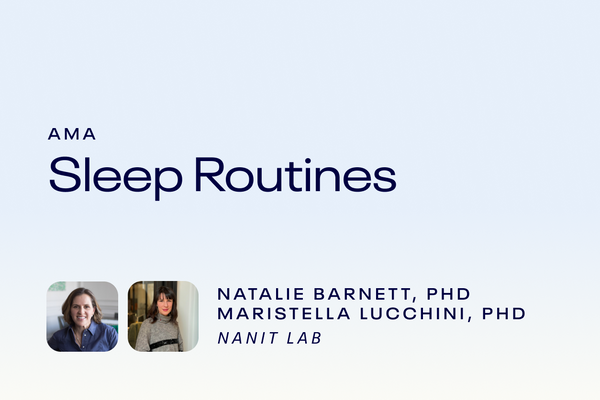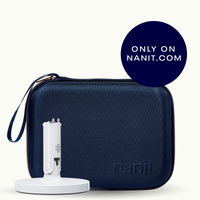There’s a lot of action in the first few years of your child’s life. From learning how to crawl and walk to melting your heart with their first gummy smile, it’s a magical time jam-packed with milestone moments.
But the one thing that your child does the most in infancy and early childhood? Sleep. This is particularly true immediately after your baby is born, when they may sleep up to 16 hours per day. And while sleep seems passive, your little one is actually incredibly hard at work behind those closed eyes, developing everything from hand-eye coordination to mastering the art of throwing their Cheerios on the floor.
So if sleep is a baby’s primary activity, why does it sometimes elude them? And can white noise help babies sleep, as your pediatrician and friends may have suggested? The short answer: Yup.
Here’s why babies like white noise and how it can ease them into better sleep.
What is white noise?
White noise machines may seem like a modern discovery, but the sound and its potential applications were discovered by engineers over a century ago. Technically characterized as an ambient hum that incorporates all of the sound frequencies audible to the human ear, white noise bears similarities to:
- A whirring fan
- A soft “shhhh”
- Radio static
- Low hissing
- An air conditioner
Seems somewhat counterintuitive to calming a restless child? Set at the right volume, white noise offers a host of benefits for adults and little ones alike.
Why does white noise help babies?
White noise is widely used in a variety of settings and for a variety of purposes. Therapists employ white noise to keep client sessions confidential. Hospitals rely on it to curb anxiety and promote patients’ sleep. Some businesses continuously play the sound to boost productivity.
But there are few places where white noise is more popular and potentially effective than in a baby’s sleeping space.
White noise may:
- Encourage your baby to fall asleep faster. An older, landmark study of 40 newborns demonstrated that 80% of babies fell asleep to the sound of white noise within five minutes.
- Increase sleep duration. According to a Nanit Lab study on the power of white noise, white noise may help babies sleep an average of two extra hours per night.
- Improve ADHD symptoms. In older children, listening to white noise may bolster cognitive tasks frequently affected by ADHD, such as reading and speech recognition. This is thanks to “stochastic resonance,” a phenomenon that’s central to all of white noise’s perks.
Research also demonstrates that white noise may increase your baby’s tolerance to pain and improve their sucking abilities.
But how and why is white noise a sleep aid for babies, exactly? Here’s how it works:
White noise mimics the womb environment
Starting around 18 weeks after conception, your baby grows accustomed to the muffled ambient noise around them in the womb. Your heartbeat, your voice, and your digestive fluids create a symphony of comforting sounds that becomes your baby’s constant soundtrack.
White noise supplies a similar steady drone, comforting in its familiarity. This may enhance your baby’s sense of security, decrease their anxiety and worries of isolation, and help them feel safe enough to drift off (and stay) asleep.
White noise masks environmental sounds
It’s no surprise: loud sounds can jar your baby out of rest. Such environmental noises include:
- Traffic and honking cars
- Sirens
- Older siblings
- Household appliances
- Yardwork
- Doorbells and ringing phones
White noise blocks out these disruptive background noises by “blanketing” your baby’s ears with an ongoing metronome. It can also ease your little one back into slumber after they’ve woken up by offering a calming, recognizable hum that assures them they’re not alone.
White noise signifies bedtime
Baths, quiet singing, a dimmed room, and a few minutes of rocking can indicate to your child that sleep is on its way. Newborns aren’t able to differentiate between day and night, but over time, your little one may start to associate the sound of white noise with sleep and use the cue to slip into dreamtime.
Is white noise the only noise that promotes sleep?
The color of noise is increasingly in the spotlight for a solid reason: Roughly 20 to 30% of babies and toddlers wrestle with sleep problems. And a recent survey determined that seven out of 10 new parents lost an average of three hours of sleep per night before their baby blew out their first birthday candle.
Since sleep deprivation can lead to a host of complications—including higher levels of stress and more reactive parenting—many parents are on a mission to find natural sleep solutions for themselves and their children.
White noise may be the most popular and well-researched, but there’s a whole spectrum of beneficial noises:
- Pink noise. Pink noise boasts a richer, deeper sound (think of your pulse between your ears or the sound of rustling leaves). Research on this sonic shade is still in its infancy, but two small studies found that it may nurture sleep.
- Brown noise. Also known as red noise, brown noise offers a more intense sound than its cousins and may resemble a low roar or distant thunder. Data indicates that it has the potential to urge humans into active, REM sleep, which accounts for approximately half of a baby’s sleep.
How to use white noise safely and effectively
Is white noise good for babies? A valid question as you may have seen headlines suggesting that white noise may do more harm than good.
The argument has basis. A decade ago, the American Academy of Pediatrics (AAP) tested 14 infant sound machines (ISMs) and discovered that all of them exceeded the noise level standardized in hospital nurseries.
Moreover, the AAP concluded that ongoing exposure to white noise above 50 decibels could damage a baby’s hearing and lead to auditory complications. So how loud should white noise be for a baby? A 2023 study published in Pediatrics confirmed that exposing a child to white noise at 85 decibels for longer than 8 hours may increase their risk of hearing loss.
To keep your baby safe:
- Invest in a baby-friendly white noise machine with proper decibel controls
- Set your white noise machine at least 7 feet away from your baby’s crib, bassinet, or other sleeping space
- Keep your white noise machine at 50 decibels or lower
- Search for signs that your baby's sleep quality is affected by the presence or volume of white noise, such as irritation, startling, and crying
How to choose the right white noise machine for your baby
Intrigued by the advantages white noise may offer? If so, look for one that offers:
- Portability, so that you can create a peaceful environment wherever you and your baby may be
- An app with audio monitoring and can alert you when your baby needs you
- A full range of soothing sounds, including white noise, lullabies, and sounds found in nature (like birds, wind, waves, and rain)
Additionally, you may want to search for an infant sound machine that includes a customizable nightlight with an array of settings to help facilitate diaper changes and nighttime feedings.
Meet Nanit’s Sound + Light
Parents throughout time have searched for the best possible sleep for their babies—but not all parents have had the magical power of white noise. Lucky you to live in this day and age. With white noise’s ability to act as a barrier against the inescapable sounds of life and resemble the murmur of a womb, it can be a powerful, persuasive tool for both your baby and you.
Nanit's Sound + Light Machine helps you turn your baby’s sleeping space into an oasis.
Equipped with a library brimming with soothing, slumber-inducing sounds and lights, as well as Cry Detection and Temperature Tracking, our sound machine stands out from the pack. And if you’d like to get more data about your baby’s sleep quality, whether it’s naptime or the middle of the night, we can help there too. Nanit Pro Camera gives you a bird’s eye view of your little one while also providing sleep tracking, analytics, and smart alerts.
Sink into a good night’s sleep with Nanit.
Key takeaways:
- Why do babies like white noise? Because it drowns out startling outside sounds, can signal bedtime, and evokes the safe, pacifying sounds of the womb.
- Studies have shown that white noise not only promotes sleep but may also help babies sleep for longer stretches.
- To protect your baby’s hearing and overall wellness, set your white noise machine at 50 decibels or lower and at least 7 feet away from your child’s sleeping space.
Sources:
Children’s Bureau. Why the first 5 years of child development are so important. https://www.all4kids.org/news/blog/why-the-first-5-years-of-child-development-are-so-important/
Better Health Channel. Typical newborn behaviour (1)-newborns 0 to 3 months. https://www.betterhealth.vic.gov.au/health/healthyliving/typical-sleep-behaviour-nb-0-3-months
Knowable Magazine. How learning happens in the brains of sleeping babes. https://knowablemagazine.org/content/article/mind/2022/how-learning-happens-brains-sleeping-babes
The New York Times. The sound of silence. https://www.nytimes.com/2018/12/27/style/white-noise-machines.html
Iranian Journal of Public Health. White noise and its potential applications in occupational health: a review. https://www.ncbi.nlm.nih.gov/pmc/articles/PMC10135504/
The Washington Post. Beyond white noise: how different ‘color’ sounds help or hurt. https://www.washingtonpost.com/home/2023/10/09/white-noise-color-sounds-brown-pink/
Healthline. What is pink noise and how does it compare with other sonic hues? https://www.healthline.com/health/pink-noise-sleep
Healthline. The pros and cons of using white noise to put babies to sleep. https://www.healthline.com/health/parenting/white-noise-for-babies
Counseling Wise. Sound machine for therapists: the best ones.https://www.counselingwise.com/sound-machine-for-therapists/
Autonomous. What is office white noise? Benefits and disadvantages. https://www.autonomous.ai/ourblog/what-is-office-white-noise
VA Diffusion Marketplace. The white noise project. https://marketplace.va.gov/innovations/the-white-noise-project
Archives of Disease in Childhood. White noise and sleep induction. https://pubmed.ncbi.nlm.nih.gov/2405784/
Complementary Therapies in Medicine. White noise as a possible therapeutic option for children with ADHD. https://www.sciencedirect.com/science/article/abs/pii/S0965229918309683
Pediatrics. Preventing excessive noise exposure in infants, children, and adolescents. https://publications.aap.org/pediatrics/article/152/5/e2023063753/194472/Preventing-Excessive-Noise-Exposure-in-Infants/
Nemours Kids Health. Breastfeeding FAQs: sleep—yours and your baby’s. https://kidshealth.org/en/parents/breastfeed-sleep.html
Healthy Children.org. When can my unborn baby hear me? I’d love to be able to read and sing to them. https://www.healthychildren.org/English/tips-tools/ask-the-pediatrician/Pages/I%E2%80%99m-pregnant-and-would-like-to-sing-to-my-unborn-baby.aspx#
Parents. How white noise can help your baby sleep. https://www.parents.com/white-noise-for-baby-how-it-can-help-infants-sleep-8413752
Today’s Parent. Is it safe to use white noise to help your baby sleep?https://www.todaysparent.com/baby/baby-sleep/white-noise-pink-noise-sound-machines-safety/
Consumer Reports. White noise for babies: ‘It’s confusing.’ https://www.consumerreports.org/babies-kids/bassinets/white-noise-for-babies-its-confusing-a3417127276/
Frontiers in Psychiatry. Parental cognitions about sleep problems in infants: a systematic review.https://www.ncbi.nlm.nih.gov/pmc/articles/PMC7779594/
The Bump. Parents lose this many nights of sleep during baby’s first year.https://www.thebump.com/news/nights-of-sleep-lost-in-first-year
Journal of Family Psychology. Maternal stress, sleep, and parenting.https://www.ncbi.nlm.nih.gov/pmc/articles/PMC6582939/
Nationwide Children’s. From wide-awake to fast-asleep: baby’s sleep patterns. https://www.nationwidechildrens.org/family-resources-education/family-resources-library/from-wide-awake-to-fast-asleep-babys-sleep-patterns
Children’s Hospital of New Orleans. World music therapy week: the benefits o f singing lullabies to your baby. https://www.chnola.org/news-blog/2023/april/world-music-therapy-week-the-benefits-of-singing/














